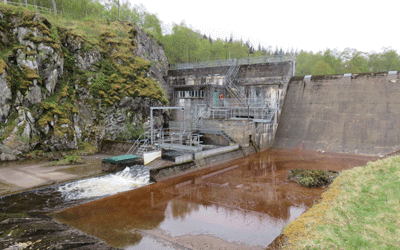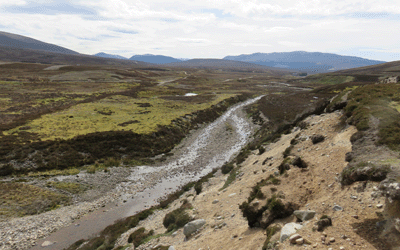Hydro electricity generation in Scotland started in the 1940’s and was a vital source of power, particularly for rural parts of the Scottish Highlands. More recently, smaller-scale, run-of-river hydro schemes have been installed in existing or new weirs. The impacts of these technologies are now well understood and Fisheries Management Scotland are working with our members to manage and mitigate these impacts.
The effect of a hydro-electric scheme on fish depends on the site, the type of scheme, and the design, construction and operation of its various elements. There are four main types: run of river; storage; pump-storage; and catchment transfer. The potential effects on fish are set out below.
Barriers to migration and access to spawning grounds
Weirs and impounding dams may obstruct the passage of salmon  or other fish unless an effective fish pass is provided. Temporary obstructions may also occur during the construction of a scheme (e.g. building of coffer dams or culverts on temporary roads) and the needs of fish must be considered.
or other fish unless an effective fish pass is provided. Temporary obstructions may also occur during the construction of a scheme (e.g. building of coffer dams or culverts on temporary roads) and the needs of fish must be considered.
Physical damage from turbines
Depending on the design of a turbine, fish passing through it may be killed or injured from changes in pressure or by being struck by turbine blades. It may therefore be necessary to provide screens at the intake to keep fish out. Screens may also be necessary at the downstream end of a tailrace to prevent fish entering it.
Pollution
Fish may be adversely affected by pollution arising during the construction and operation of a scheme (Hydro firm caused ‘hundreds of years’ of damage – The Scotsman).
Transfer of water between catchments
As well as the hydrological effects of catchment transfer, fish can gain access to previously uninhabited watercourses via the tunnel used to transfer water. This could potentially lead to the transfer of water-borne infection. Salmon are thought to recognize chemical attractants in their home waters, so catchment transfer also has the potential to mislead fish up a ‘wrong’ tributary.
Other changes in hydrology
Hydro-electric schemes change the hydrology within the area of the development, and, in cases of catchment transfer, beyond it.  These changes include:
These changes include:
- In run of river schemes there is usually a large reduction of flow in the river channel between the water intake and the discharge from the power station. This may also occur downstream from the impounding dam of a storage scheme. If a sufficient residual flow is not provided, the stocks of fish in these areas will be lost or significantly reduced and the passage of migratory salmon will be prevented. A required residual flow is usually called a ‘compensation flow’.
- If a stretch of river is dammed, the resulting reservoir may destroy fish spawning grounds or nursery areas. In storage schemes, depending on the pattern of generation, the flow downstream of the power station may fluctuate markedly and this could adversely affect fish or fisheries. The water level in the reservoir may also fluctuate, affecting fish stocks.
- Catchment transfers can result in substantial changes in flow in the affected catchments with consequential effects on fish or fisheries.
- There are other indirect effects, such as changes in sediment transport which can alter the character of a river bed, which in turn may affect fish stocks.
Generators of electricity are required to, “avoid, so far as possible, causing injury to fisheries or to the stocks of fish in any waters” (Schedule 9 of the Electricity Act 1989).
What are we doing?
Fisheries Management Scotland works at a strategic level, in order to influence the prioritisation of the CAR licence review process to ensure free passage of wild salmonids and adequate compensation flows are provided to allow fish to migrate through the river. Much of this work occurs via SEPA’s Fish and Fisheries Advisory Group. Our members are working with hydro operators to manage and mitigate known problems. This includes ‘trapping’ smolts above dams and ‘trucking’them downstream where free passage of fish to sea is available. Hydro operators have a responsibility and commitment to manage impacts on biodiversity and the natural world in a responsible and sustainable way – we are working to ensure that these responsibilities are
